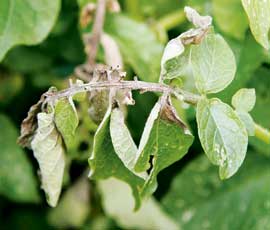Two new potato blight fungicides enter crowded market

Potato growers have two additional blight fungicide choices this year after BASF launched two new products into an already crowded market.
Resplend and Decabane both contain Initium (ametoctradin), a new active ingredient offering both foliar and tuber blight activity.
BASF laboratory trials show that ametoctradin causes zoospores – the causal agents of tuber blight in potatoes – to burst within seconds of application and at very low concentrations.
Both products have been co-formulated with complementary active ingredients with different modes of action to offer a strong anti-resistance position, explains Rob Storer, potato product manager for BASF.
“They will be important new tools in the fight against both foliar and tuber blight, as well as in resistance management,” he says.
Resplend, a liquid formulation of ametoctradin plus dimethomorph, can be applied at the rapid canopy, stable canopy and senescence stages of potato development.
But Decabane contains ametoctradin plus mancozeb, co-formulated as a water-dispersable granule and targeted at the blight programme during stable canopy.
Kristin Klappach, BASF researcher in global fungicide development, says ametoctradin works by inhibiting fungal energy production, similar to strobilurins, although not at a different target site. No cross-resistance between the two groups has been observed.
“Initium forms a stable layer on the leaf surface, providing a protective shield through absorption on the wax layer, and it can be redistributed on leaves under the influence of moisture,” she says.
Peter Clare, managing director of Cheshire-based distributor Environmental Crop Management, used Resplend last year from the middle of his blight programmes onwards.
“Resplend has got curative action (on late infections) and tuber blight protection, which you have not got with any other product,” he says. “With the dimethomorph, if we get a bit of blight it will knock that out and we’re also getting tuber blight control. Cheshire can have high levels of rainfall and because Resplend is rainfast within an hour, it’s a big advantage,” he says.
“There’s no point thinking you have got the best product in the world if you put it on and then it gets washed off.”
Resplend and Decabane can be applied at seven to ten-day intervals and ametoctradin can be applied up to four times in any one crop. Both are available to purchase now.
BASF trials in action
John Keer, a potato development agronomist from Agrochemex, trialled Resplend last year and saw how both products performed in BASF trials.
But he considers that neither Resplend nor Decabane will trouble the recognised top three potato blight fungicides on the market – Revus (mandipropamid), Ranman (cyazofamid) and Infinito (propamocarb + fluopicolide).
“The two new BASF products won’t let you down, but they’re not up there with the very best,” he says. “Instead, I would place them towards the top of the next tier of products.”
Resplend and Decabane have slightly different positions in the blight programme due to their different chemical formulations, he explains.
“Resplend is more targeted towards the beginning of the blight programme, whereas Decabane would be more towards the middle because of the active ingredients they contain.
“The dimethomorph in Resplend offers translaminar activity and quite a bit of kickback, whereas the mancozeb in Decabane offers additional protectant activity.”
He points out that both products offer useful protectant activity against alternaria.
Senior Scottish Agricultural College (SAC) potato consultant, John Sarup, adds: “At the moment, Revus and Ranman are the two best products available in terms of rainfastness and what they offer as a protectant. Resplend and Decabane are just something else to use, but they are no better than the others. They’re not going to alter my blight spray programmes in any way.”

